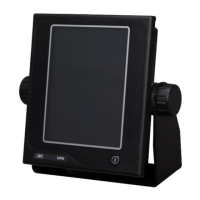Appendix-28
・VHW – Water speed and heading
$--VHW, x.x, T, x.x, M, x.x, N, x.x, K*hh<CR><LF>
1 2 3 4 5 6 7 8
1:Heading, degrees true
2:Heading, degrees true
3:Heading, degrees magnetic
4:Heading, degrees magnetic
5:Speed, knots
6:Speed, knots
7:Speed, km/h
8:Speed, km/h
・RTE – Routes
$--RTE, x.x, x.x, a, c--c, c--c,...... c--c*hh<CR><LF>
1
2 3 4 5 6 7 8
1:Total number of sentences being transmitted (see Note 2)
2:Sentence number (see Note 2)
3:Message mode: c = complete route, all waypoints
w = working route, first listed waypoint is "FROM",
second is "TO" and remaining are rest of route
4:Route identifier
5:Waypoint identifier
6:Additional waypoint identifiers (see Note 1)
7:Additional waypoint identifiers (see Note 1)
8:Waypoint "n" identifier (see Note 1)
NOTE 1 A variable number of waypoint identifiers, up to "n", may be included within the limits of allowed sentence
length. As there is no specified number of waypoints, null fields are not required for waypoint identifier fields.
NOTE 2 A single route may require the transmission of multiple sentences, all containing identical field formats
when sending a complex message. The first field specifies the number of sentences, minimum value = 1. The
second field identifies the order of this sentence (sentence number), minimum value = 1. For efficiency, it is
permitted that null fields be used in the additional sentences when the data is unchanged from the first sentence.
(Note that this practice can lead to the incorrect assembly of sentences if there is a high risk of loss of sentence.)
・WPL – Waypoint location
$--WPL, llll.ll, a, yyyyy.yy, a, c--c*hh<CR><LF>
1 2 3 4 5
1:Waypoint latitude, N/S
2:Waypoint latitude, N/S
3:Waypoint longitude, E/W
4:Waypoint longitude, E/W
5:Waypoint identifier
・ACK – Acknowledge alarm
$--ACK,xxx*hh<CR><LF>
1
1:Unique alarm number (identifier) at alarm source

